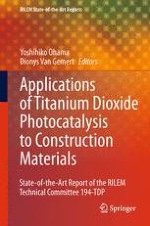2011 | Buch
Applications of Titanium Dioxide Photocatalysis to Construction Materials
State-of-the-Art Report of the RILEM Technical Committee 194-TDP
herausgegeben von: Yoshihiko Ohama, Dionys Van Gemert
Verlag: Springer Netherlands
Buchreihe : RILEM State-of-the-Art Reports
